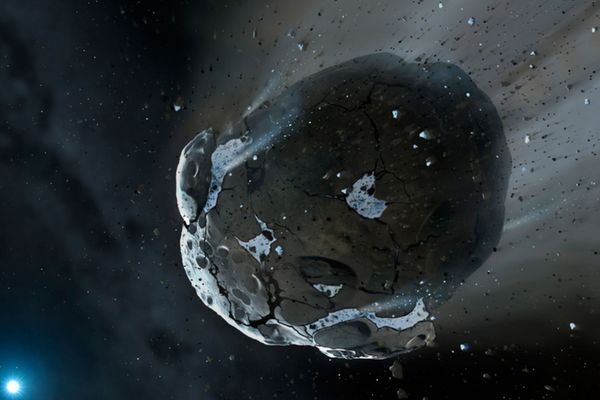Model an asteroid
Make a scaled asteroid model from clay and recycled materials, create craters by dropping small clay balls, and learn about composition, scale, and impact effects.



Step-by-step guide to make a scaled asteroid model
Asteroids Explained: NASA Discoveries and Facts You Need to Know!
Step 1
Gather all your materials and place them on a clean flat workspace.
Step 2
On your paper write the real asteroid diameter in kilometers that you want to model.
Step 3
Write a scale on your paper to turn kilometers into centimeters (for example write "1 cm = 10 km").
Step 4
Calculate the model diameter in centimeters using your scale and write that number on the paper.
Step 5
Cut or trim a piece of recycled cardboard to make a flat base and put it on your workspace.
Step 6
Roll modeling clay into a ball that matches the model diameter and check the size with your ruler.
Step 7
Roll a small ball of a different colored clay to be the asteroid's core.
Step 8
Press the small core into the center of your clay ball and smooth the outer clay so the core is hidden inside.
Step 9
Roll at least three small impactor balls of different sizes from the extra clay.
Step 10
Hold a small impactor about 10 centimeters above the asteroid and drop it straight down to make a crater.
Step 11
Hold a larger impactor higher up (for example 30 centimeters) and drop it to make a bigger crater.
Step 12
Look carefully at the craters and note which craters are wider or deeper and how the impactor size and drop height changed them.
Step 13
Write your observations on your paper about scale composition and impact effects.
Step 14
Label the cardboard base with your model scale and a short note about the asteroid’s composition using a pen or colouring materials.
Step 15
Take photos or a short description of your finished asteroid model and share your creation on DIY.org
Final steps
You're almost there! Complete all the steps, bring your creation to life, post it, and conquer the challenge!


Help!?
What can we use if we don't have modeling clay or recycled cardboard?
If you don't have modeling clay use Play-Doh or air-dry clay and substitute the recycled cardboard base with a cereal box panel or foam board while checking sizes with any ruler or measuring tape.
What should we do if the clay ball isn't the right size or the core keeps showing through?
Re-measure the intended model diameter with your ruler and either add or trim clay to match the calculated centimeters, press the colored core deeper into the ball, then smooth the outer clay again before rolling impactors.
How can we change the activity for younger kids or older kids?
For younger children simplify the scale to 1 cm = 100 km, pre-roll the asteroid and impactor balls and have an adult cut the cardboard base, while older kids can measure crater widths with the ruler, repeat drops from different heights, and record detailed observations on the paper.
How can we make the asteroid model more realistic or turn it into a longer project?
Press sand or fine gravel into the outer clay before dropping impactors to change surface texture, paint and label the finished model on the cardboard base with composition notes, and photograph each crater to compare widths and depths for a mini science report.
Watch videos on how to make a scaled asteroid model
How Do Scientists Track Asteroids And Comets? - Astronomy Made Simple
Facts about planetary science for kids
🪐 Asteroids range from tiny pebbles to Ceres, which is almost 940 km across — some are big enough to be dwarf planets.
💥 Many impacts happen at tens of kilometers per second, so even a small rock can release a huge burst of energy on impact.
🌑 On very small asteroids gravity is so weak that crater material can be thrown far away or even escape into space, making their surfaces look wild.
📏 Scales make modeling easy: at 1:1,000,000 scale (1 mm = 1 km), a 10 km asteroid would be just 1 cm — perfect for a clay model!
🧱 Some asteroids are actually 'rubble piles' — loose collections of rocks and dust held together by gravity rather than solid rock.
How do I make a scaled asteroid model with clay and recycled materials?
What materials do I need to model an asteroid at home?
What ages is this scaled asteroid activity suitable for?
What are the benefits of making a scaled asteroid model?


One subscription, many ways to play and learn.
Only $6.99 after trial. No credit card required


